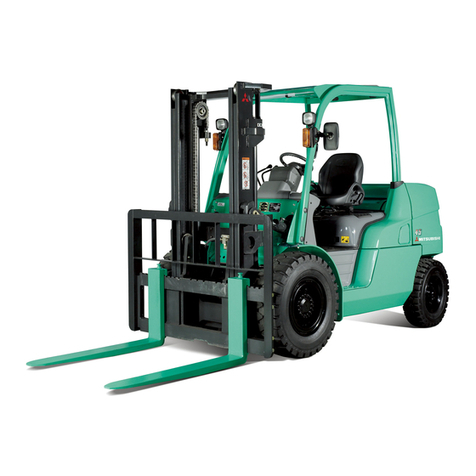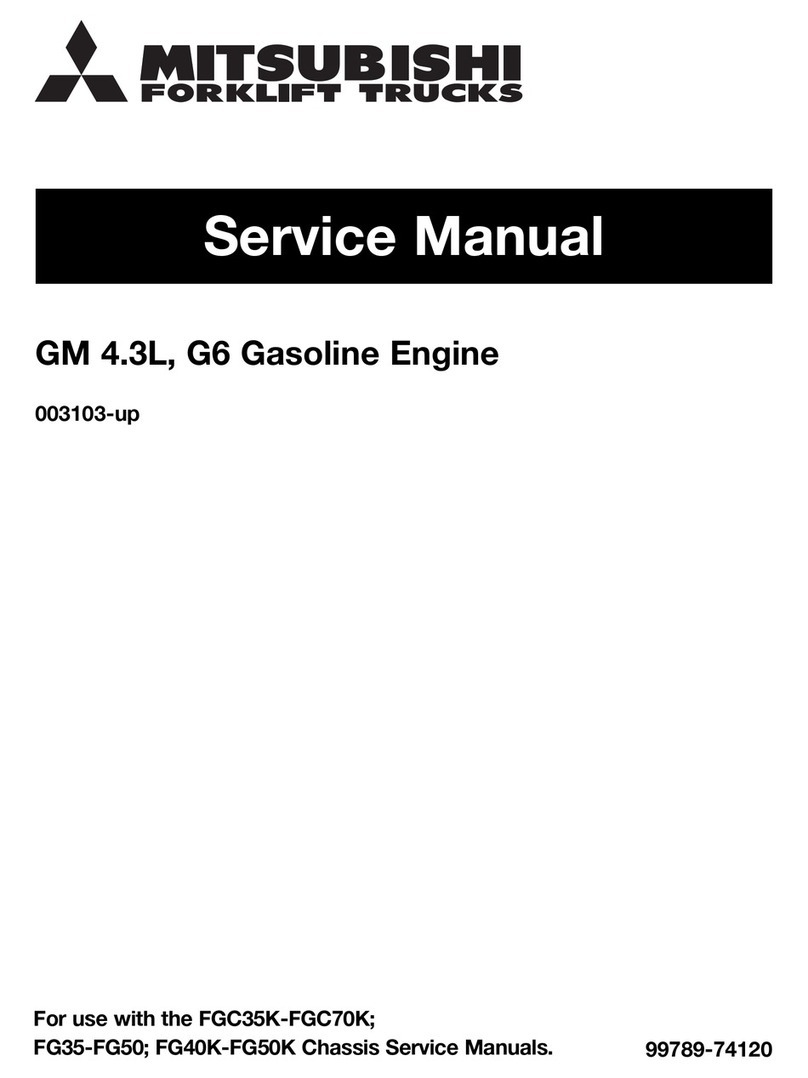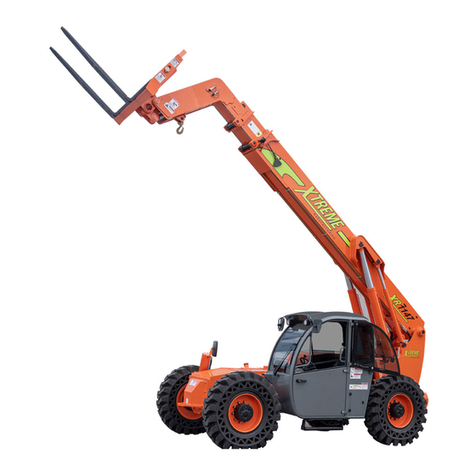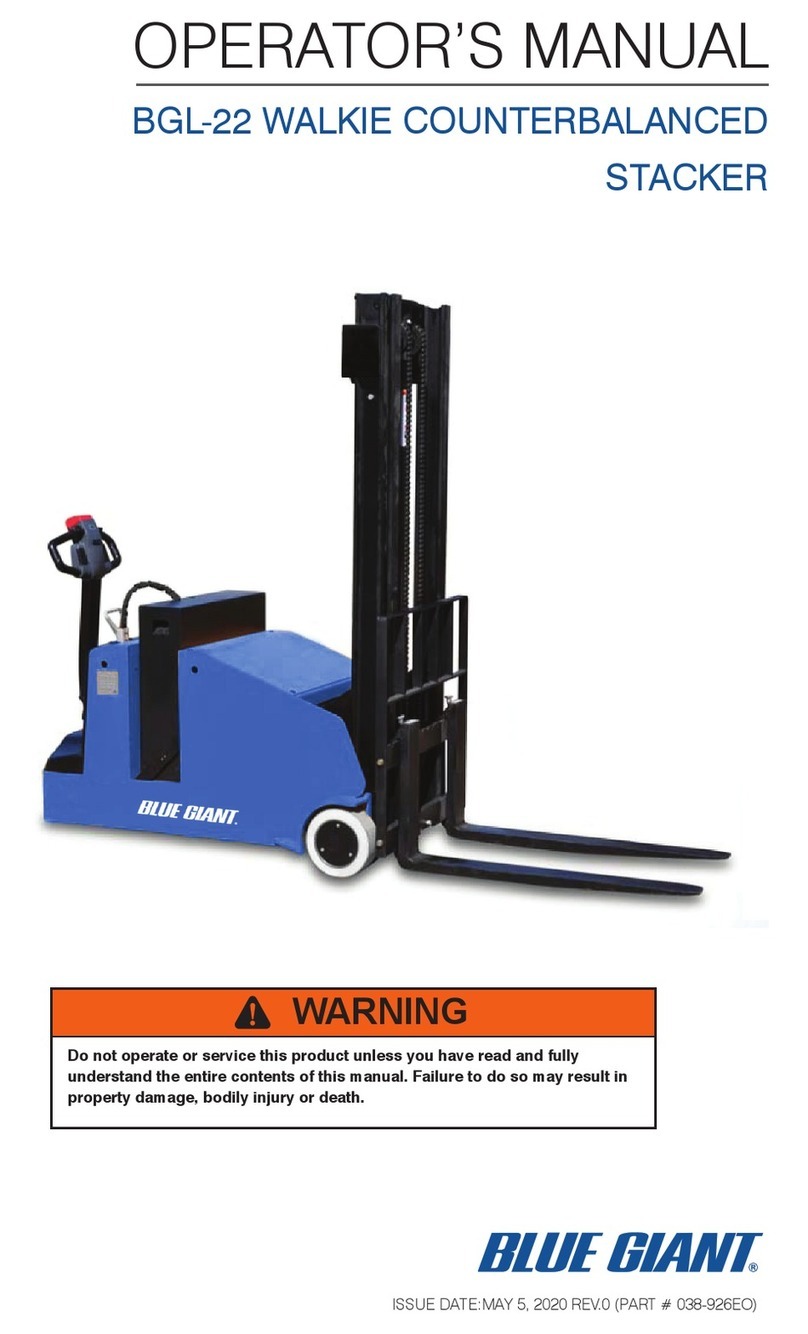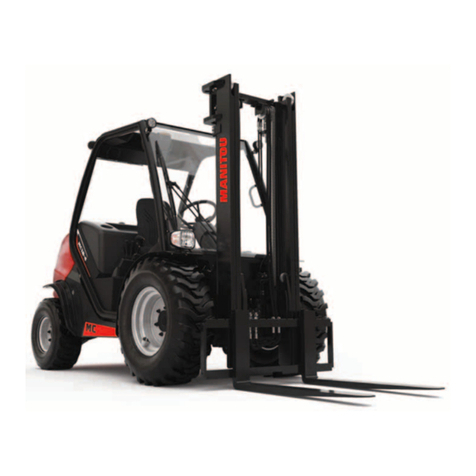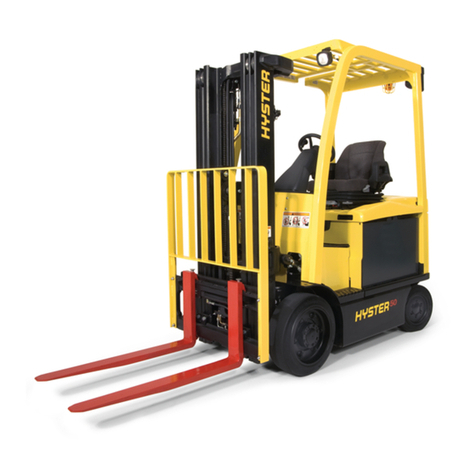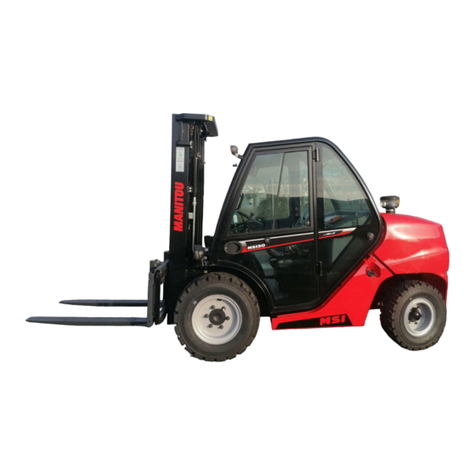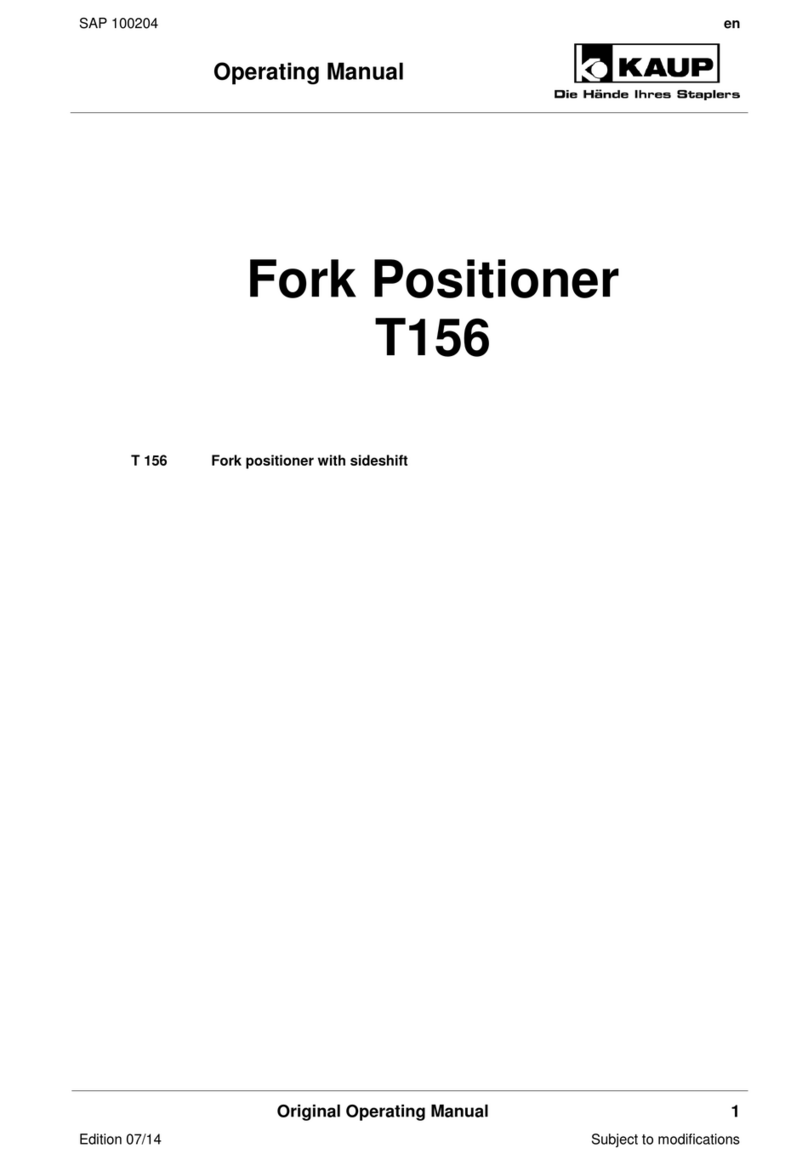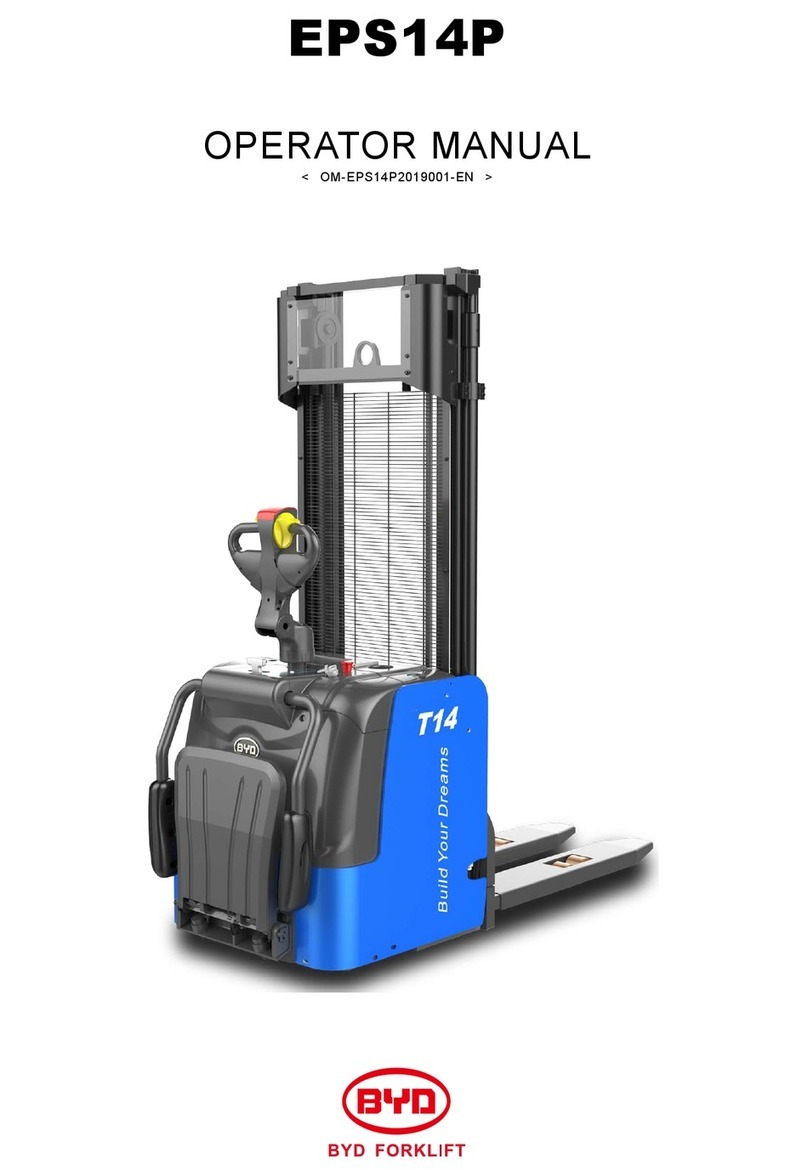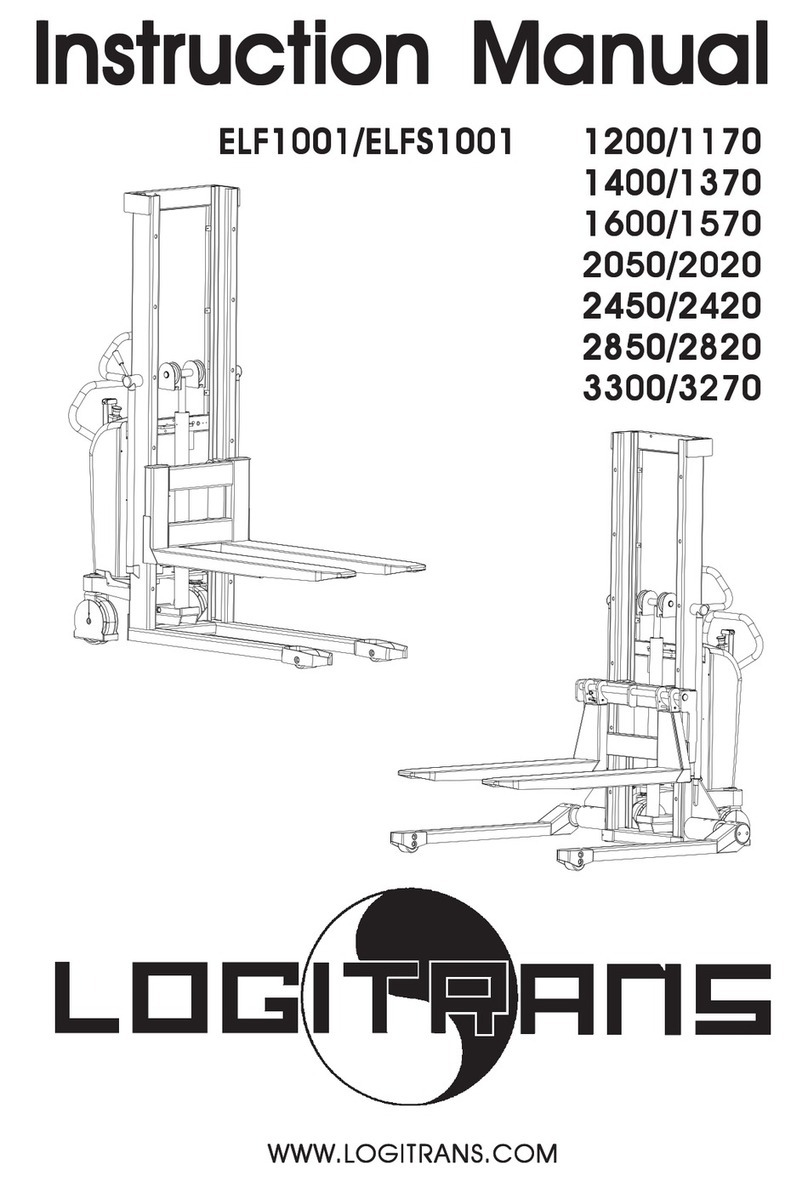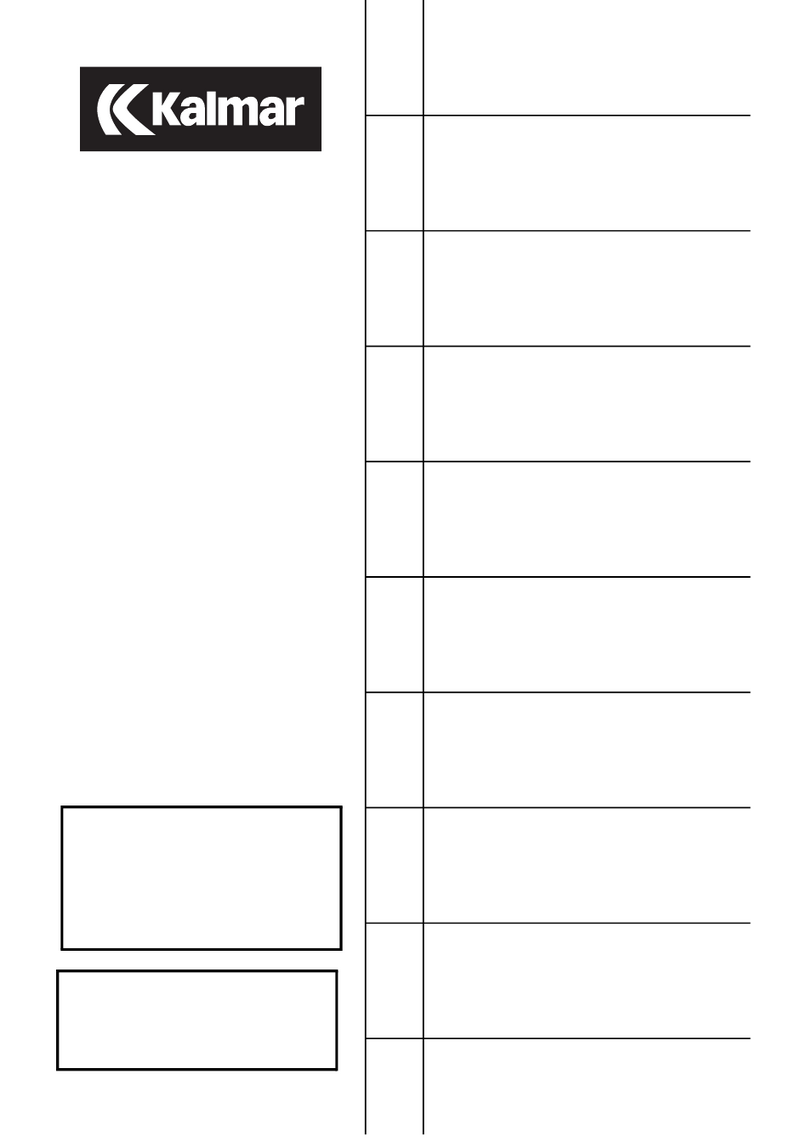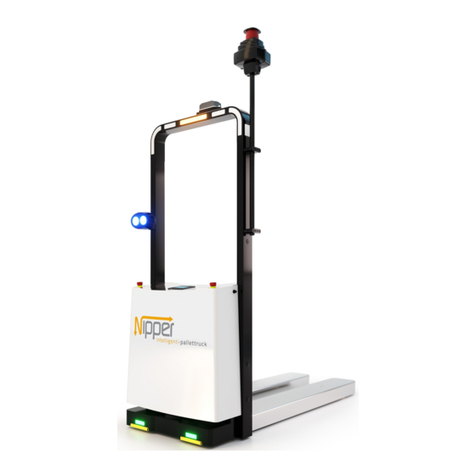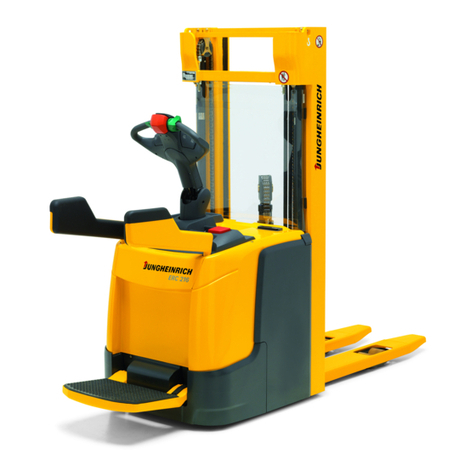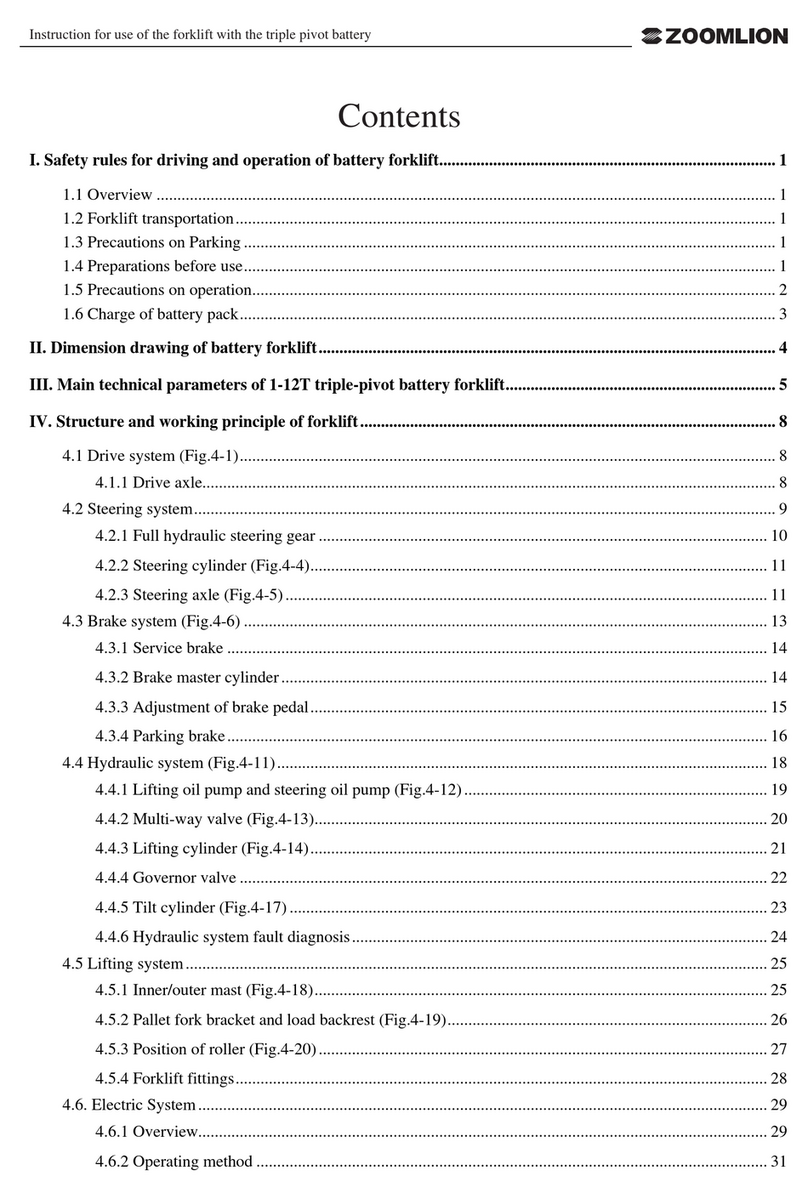Mitsubishi FB16N User manual

Service Manual
99759-57110
Chassis, Mast & Options
FB16N EFB15-20011-up
FB18N EFB15-70001-up
FB20CN EFB17-20011-up
MC/FC
For use with FB16N-FB20CN
Controller Service Manual.

FOREWORD
This service manual is a guide for servicing Mitsubishi forklift trucks. For your convenience the
instructions are grouped by systems as a ready reference.
The long productive life of your forklift truck(s) depends on regular and proper servicing.
Servicing consistent with what you will learn by reading this service manual. Read the
respective sections of this manual carefully and familiarize yourself with all of the components
before attempting to start a test, repair or rebuild job.
The descriptions, illustrations and specifications contained in this manual are for the trucks with
serial numbers in effect at the time of printing. Mitsubishi forklift trucks reserve the right to
change specifications or design without notice and without incurring obligation.
Pub. No. 99759-57110
Safety Related Signs
The following safety related signs are used in this service
manual to emphasize important and critical instructions:
Indicates a potentially hazardous
situation which, if not avoided, could
result in death or serious injury.
Indicates a potentially hazardous
situation which, if not avoided, may
result in death or serious injury or
damage to the machine.
Indicates a condition that can cause
damage to, or shorten service life of,
the machine.
NOTE
WARNING
!
CAUTION
!

4. Lower the forks or other implements to the ground
before performing any work on the truck. If this
cannot be done, make sure the forks or other
implements are blocked correctly to prevent them
from dropping unexpectedly.
5. Use steps and grab handles (if applicable) when
mounting or dismounting a truck. Clean any mud
or debris from steps, walkways or work platforms
before using. Always face truck when using
steps, ladders and walkways. When it is not
possible to use the designed access system,
provide ladders, scaffolds, or work platforms to
perform safe repair operations.
6. To avoid back injury, use a hoist when lifting
components which weigh 23 kg (50 lb.) or more.
Make sure all chains, hooks, slings, etc., are in
good condition and are of the correct capacity. Be
sure hooks are positioned correctly. Lifting eyes
are not to be side loaded during a lifting
operation.
7. To avoid burns, be alert for hot parts on trucks
which have just been stopped and hot fluids in
lines, tubes and compartments.
8. Be careful when removing cover plates.
Gradually back off the last two bolts or nuts
located at opposite ends of the cover or device and
pry cover loose to relieve any spring or other
pressure, before removing the last two bolts or
nuts completely.
9. Be careful when removing filler caps, breathers
and plugs on the truck. Hold a rag over the cap or
plug to prevent being sprayed or splashed by
liquids under pressure. The danger is even greater
if the truck has just been stopped because fluids
can be hot.
The serviceman or mechanic may be unfamiliar with
many of the systems on this truck. This makes it
important to use caution when performing service
work. A knowledge of the system and/or components
is important before the removal or disassembly of any
component.
Because of the size of some of the truck components,
the serviceman or mechanic should check the weights
noted in this Manual. Use proper lifting procedures
when removing any components.
Following is a list of basic precautions that should
always be observed.
1. Read and understand all warning plates and decals
on the truck before operating, lubricating or
repairing the product.
2. Always wear protective glasses and protective
shoes when working around trucks. In particular,
wear protective glasses when pounding on any
part of the truck or its attachments with a hammer
or sledge. Use welders gloves, hood/goggles,
apron and other protective clothing appropriate to
the welding job being performed. Do not wear
loose-fitting or torn clothing. Remove all rings
from fingers when working on machinery.
3. Do not work on any truck that is supported only
by lift jacks or a hoist. Always use blocks or jack
stands to support the truck before performing any
disassembly.
SAFETY
The proper and safe lubrication and maintenance
for these forklift trucks, recommended by
Mitsubishi Forklift Trucks, are outlined in the
OPERATION & MAINTENANCE MANUAL.
Improper performance of lubrication or
maintenance procedures is dangerous and could
result in injury or death. Read and understand the
OPERATION & MAINTENANCE MANUAL before
performing any lubrication or maintenance on
these trucks.
Do not operate these trucks unless you have
read and understood the instructions in the
OPERATION & MAINTENANCE MANUAL.
Improper truck operation is dangerous and could
result in injury or death.
WARNING
!WARNING
!
WARNING
!

10. Always use tools that are in good condition and
be sure you understand how to use them before
performing any service work.
11. Reinstall all fasteners with same part number.
Do not use a lesser quality fastener if
replacements are necessary. Do not mix metric
fasteners with standard nuts and bolts.
12. If possible, make all repairs with the truck
parked on a level, hard surface. Block truck so it
does not roll while working on or under truck.
13. Disconnect battery and discharge any capacitors
(electric trucks) before starting to work on truck.
Hang “Do not Operate” tag in the Operator’s
Compartment.
14. Repairs, which require welding, should be
performed only with the benefit of the
appropriate reference information and by
personnel adequately trained and knowledgeable
in welding procedures. Determine type of metal
being welded and select correct welding
procedure and electrodes, rods or wire to provide
a weld metal strength equivalent at least to that
of parent metal.
15. Do not damage wiring during removal
operations. Reinstall the wiring so it is not
damaged nor will it be damaged in operation by
contacting sharp corners, or by rubbing against
some object or hot surface. Do not connect
wiring to a line containing fluid.
16. Be sure all protective devices including guards
and shields are properly installed and functioning
correctly before starting a repair. If a guard or
shield must be removed to perform the repair
work, use extra caution.
17. Always support the mast and carriage to keep
carriage or attachments raised when maintenance
or repair work is performed, which requires the
mast in the raised position.
18. Loose or damaged fuel, lubricant and hydraulic
lines, tubes and hoses can cause fires. Do not
bend or strike high pressure lines or install ones
which have been bent or damaged. Inspect lines,
tubes and hoses carefully. Do not check for
leaks with your hands. Pin hole (very small)
leaks can result in a high velocity oil stream that
will be invisible close to the hose. This oil can
penetrate the skin and cause personal injury. Use
cardboard or paper to locate pin hole leaks.
19. Tighten connections to the correct torque. Make
sure that all heat shields, clamps and guards are
installed correctly to avoid excessive heat,
vibration or rubbing against other parts during
operation. Shields that protect against oil spray
onto hot exhaust components in event of a line,
tube or seal failure, must be installed correctly.
20. Relieve all pressure in air, oil or water systems
before any lines, fittings or related items are
disconnected or removed. Always make sure all
raised components are blocked correctly and be
alert for possible pressure when disconnecting
any device from a system that utilizes pressure.
21. Do not operate a truck if any rotating part is
damaged or contacts any other part during
operation. Any high speed rotating component
that has been damaged or altered should be
checked for balance before reusing.

HOW TO USE THIS MANUAL
(Removal, Installation, Assembly and Disassembly)
Disassembly diagram (example)
Suggestion for disassembling
1. Output shaft, Removing
Remove output shaft using a special tool.
Service Data
A: Standard Value
B: Repair or Service Limit
1
2
209603
Sequence
1 Cover, Bolt, Washer (part name)
2 Snap ring ................ (part name)
A0.11 to 0.28 mm
Gear Backlash (0.0043 to 0.0110 in.)
B 0.5 mm (0.020 in.)
209604
Disassembling sequence
Procedures are described in the text.

Symbols or abbreviation
OP Option
R1/4 Taper pipe thread (external) 1/4 inch (formerly PT1/4)
Rc1/8 Taper pipe thread (internal) 1/8 inch (formerly PT1/8)
G1/4A Straight pipe thread (external) 1/4 inch (formerly PF1/4-A)
Rp1/8 Straight pipe thread (internal) 1/8 inch (formerly PS1/8)
Units
1. SI Units are used in this manual.
2. The following table shows the conversion of SI unit and customary unit.
Item SI unit Customary unit
Force 1 N 0.1020 kgf
(1 lbf) (0.4536 kgf)
Pressure 1 kPa 0.0102 kgf/cm2
(1 psi) (0.0703 kgf/cm2)
Torque 1 N·m 0.1020 kgf·m
(1 lbf·ft) (0.1383 kgf·m)

GROUP INDEX Items
1
2
3
4
5
6
7
8
9
10
GROUP INDEX
GENERAL INFORMATION
VEHICLE ELECTRICAL
COMPONENT
POWER TRAIN
TRANSFER UNIT
REAR AXLE
BRAKE SYSTEM
STEERING SYSTEM
HYDRAULIC SYSTEM
MAST AND FORKS
SERVICE DATA
Console box, Direction lever, Accelerator control, Key switch, Fuses, Lamp
specification chart, Troubleshooting of lighting and horn systems, Joystick box
Procedures and suggestions for removal and installation, Service data
Specifications, Structure and functions, Procedures and suggestions for
disassembly and reassembly, Service data
Structure, Procedures and suggestions for removal and installation, Procedures
and suggestions for disassembly and reassembly, Adjustment, Troubleshooting,
Service data
Specifications, Structure and functions, Procedures and suggestions for
disassembly and reassembly, Inspection and adjustment, Troubleshooting,
Service data
Specifications, Structure and functions, Procedures and suggestions for removal
and installation, Steering control valve, Hydraulic circuit diagram,
Troubleshooting, Service data
Specifications, Finger-tip control type (Description, Removal and installation,
Disassembly and reassembly, Inspection and adjustment, Hydraulic circuit
diagram), Mechanical control type (Control valve, Removal and installation,
Hydraulic circuit diagram), Troubleshooting, Service data
Mast systems, Description, Removal and installation, Disassembly and
reassembly, Inspection and adjustment, Troubleshooting, Service data
Vehicle exterior, Models, Serial number locations, Chassis and mast model
identification, Dimensions, Technical data
Inspection standards, Periodic replacement of parts, Lubrication standards, Main
component weights, Tightening torque for standard bolts and nuts, Special tool
table

Vehicle Exterior ........................................................................................ 1 – 1
Models ....................................................................................................... 1 – 1
Serial Number Locations ....................................................................... 1 – 2
Chassis and Mast Model Identification ............................................... 1 – 3
Dimensions ............................................................................................... 1 – 4
Technical Data .......................................................................................... 1 – 5
1
GENERAL INFORMATION

1-1
GENERAL INFORMATION
Truck Model Serial Number
FB16N EFB15-20011-up
FB18N EFB15-70001-up
FB20CN EFB17-20011-up
211146
Vehicle Exterior
Models
This manual applies to FB16N, FB18N and FB20CN.
Control lever
(MC models)
Joystick box
(FC models)

1-2
GENERAL INFORMATION
Mast number Chassis number Nameplate
211270
Serial Number Locations

1-3
GENERAL INFORMATION
Chassis and Mast Model Identification
[Chassis]
FB 16 N
Generation designator
Maximum capacity
16: 1600 kg (3500 lb)
18: 1800 kg (4000 lb)
20: 2000 kg (4400 lb)
Maximum lifting height
[“30” stands for 3000 mm (118 in.)]
Order of the minor change
(“A” for the original, “B” for the first change, “C” for
the second change, and so on)
Applicable truck model designation
15: 1 ton class
20: 2 ton class
Kind of mast
G: simplex mast
H: duplex mast
J: triplex mast
Major change
(“1” for the original, “2” for the first change, and so
on up to “9”)
Battery type
[Mast]
2 G 15 A 30

1-4
GENERAL INFORMATION
Dimensions
A
D
C
BEF
213416

1-5
GENERAL INFORMATION
Technical Data
Truck Models FB16N FB18N FB20CN
Class 1.6 ton 1.8 ton 2.0 ton
Load Capacity/Load Center N (kgf)/mm 15690 (1600)/500 17650 (1800)/500 19610 (2000)/500
[lbf/in.] [3530/20] [3970/20] [4410/20]
Truck size
Length to Fork Face
Amm (in.) 2074 (81.7) 2074 (81.7) 2188 (86.1)
W
idth
Bmm (in.) 1070 (42.1) 1070 (42.1) 1130 (44.5)
Height of Overhead C2048 (80.6) 2048 (80.6) 2048 (80.6)
Guard mm (in.)
Wheelbase Dmm (in.) 1360 (53.5) 1360 (53.5) 1463 (57.6)
Truck weight, without load/ 3190 (7033) 3280 (7231) 3470 (7650)
including battery kg (lb)
Tread Front/Rear E/F mm 913/898 913/898 935/898
(in.) (35.9/35.4) (35.9/35.4) (36.8/35.4)
Tires Size Front 18 x 7-8 18 x7-8 200/50-10
Rear 16 x6-8 16 x6-8 16 x6-8
Turning Radius mm (in.) 1810 (71.3) 1810 (71.3) 1910 (75.2)
Travel Speeds Unloaded/Loaded
km/h (mph)
17/17 (10.6/10.6) 17/17 (10.6/10.6) 17/17 (10.6/10.6)
Maximum Gradeability 35/27 35/25 35/24
Unloaded/Loaded %
Lift Speeds Unloaded/Loaded m (in.)/sec
0.60/0.50 (23.6/19.7) 0.60/0.44 (23.6/17.3)
0.60/0.40 (23.6/15.7)
Lowering Speed Unloaded/Loaded
m (in.)/sec
0.5/0.52 (19.7/20.5) 0.5/0.52 (19.7/20.5) 0.5/0.52 (19.7/20.5)
Battery Voltage V 48 48 48
Battery Rated Capacity (5 hrs.) MAX Ah 600 600 720
Battery Compartment Size mm 1006 x521 x650 1006 x521 x650 1006 x624 x650
(in.) (39.6 x20.5 x25.6) (39.6 x20.5 x25.6) (39.6 x24.6 x25.6)
Battery Weight kg (lb) 865 (1907) 865 (1907) 1000 (2205)
Tilt Angle (forwards-backwards) 6°-7° 6°-7° 6°-7°
Traction Motor, 60 min rating kW 2 x5.0 2 x5.0 2 x5.0
Hydraulic Motor (15% duty) kW 14 14 14
Traction Motor Control Method MOSFET MOSFET MOSFET
Hydraulic Motor Control Method MOSFET MOSFET MOSFET
This manual suits for next models
2
Table of contents
Other Mitsubishi Forklift manuals


